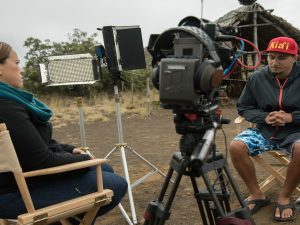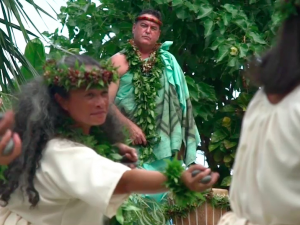Supporting local now has a new look with Nā Mea Hawaiʻi’s labeling system.
“I’m excited because it’s part of a trend. People want to buy local, you can’t buy any more local than buying something made- maoli made with maoli materials,” says Maile Meyer, who is owner of Native Hawaiian Books. “There’s so many imitations, we just want people to know the real thing.”
Nā Mea Hawaiʻi has a new pilot program under the Hawaiian Way Fund that recognizes contemporary Hawaiian artists and cultural practitioners through a label.
“Every island has incredible locally made things and it has a wonderful multiplier so every dollar that you spend turns into $4.20 when spent locally because of how we, in this place, use our resources. So it’s a great way to be sustainable,” says Maile.
There are two labels, each featuring a brown or a green man. If you look closely however, you’ll notice that these men are made up of the letters N, M and H for Nā Mea Hawaiʻi, meaning things Hawaiian.
“The green kanaka maoli symbol is if the maker or the materials are Maoli and the brown mark is if they’re both,” says Maile.
“It’s a symbol of people, place and culture and that this is from us because so many people call Hawaiʻi home now, this is still within our host culture and from our own people and that we still can- we can be traditional, we can be contemporary and we draw upon our roots,” says Punawai Rice, designer of Punawai clothing.
For Gwen Kamisugi, a lauhala weaver, it’s all about tradition. “Our lauhala is, the way the label is made, people will know that we picked and gathered and prepped our own material in a true cultural way.”
Soon, Hawaiʻi will be just one of the many places seeing this label.
“The thought of whether or not a kanaka maoli symbol can go internationally/world-wide I think that it absolutely can, it has in many other ways whether it’s aloha or macadamia nuts, so why wouldn’t it? especially because people associate aloha and caring with our community,” says Maile. “So for Hawaiians to be able to represent internationally, I think the market is one way that we can help.”
“We’re trying hard to perpetuate what our kūpuna have taught us and that is part of our oral tradition of doing things. So the sticker will be able to tell people we are practicing what we have learned from our kūpuna,” says Gwen.
“ʻO ke kākoʻo ʻana i nā ʻoihana kūloko kekahi mea e kū ana i ke au a ua kūpono kēia i loko o kēlā makemake o kānaka, ʻoiai he mea maoli nō ia,” wahi a Maile Meyer, ka mea nona ka halekūʻai ʻo Native Hawaiian Books.
He polokalamu hou ko Nā Mea Hawaiʻi ma lalo o ka Hawaiian Way Fund e hoʻomaopopo ana i ka lehulehu e pili ana i ka lole, nā hana noʻeau hou o kēia au a me nā hana noʻeau kuʻuna o Hawaiʻi nei ma o kekahi lēpili.
“Mio wale ka hana a ko kākou poʻe a puni o Hawaiʻi paeʻāina a ua kūpono kēia hoʻihoʻi ʻia o ka $4.20 i ka ʻāina ʻoiai mai laila nō ua mau kumu waiwai,” wahi a Maile.
He ʻelua lēpili i hoʻokumu ʻia ma loko o kēia polokalamu nei. ʻO kekahi he ʻōmaʻomaʻo a ʻo kekahi he makuʻe. Ma ka maka mua, kohu kanaka ke nānā aku. Eia naʻe, ke nānā maikaʻi, ua haku ʻia kēia mau kanaka nei me nā hua palapala ʻo N, M a me H e kū ana no “Nā Mea Hawaiʻi”, a ua kūpono hoʻi no ka manaʻo kaona o ia mau lēpili.
“Inā ʻo ke kanaka a i ʻole ʻo nā lako he Hawaiʻi, ua ʻōmaʻomaʻo ke kanaka,” wahi a Maile. “ʻO ka makuʻe, ʻo ia nā mea ʻelua.”
“He hōʻailona ia o ko kākou hiki ke noho ma Hawaiʻi nei me ke kuana ʻike hou me ka nānā mau ʻana i ko kākou ʻike kuʻuna,” wahi a Punawai Rice, ke kanaka haku lau hoʻi o ka lole ʻo Punawai.
A no Gwen Kamisugi, he ʻulana lauhala hoʻi, he kuʻuna nō kāna hana. “He kōkua kēia lēpili iā kākou ma ka hoʻōia ʻana i ke ʻano e kuʻuna ai kā kākou hana ma ka ʻulana lauhala.”
A ʻoiai he hoʻomaka wale nō kēia, ʻaʻohe mea e hōʻole ana i ka holomua nui ʻana o kēia lēpili ma Hawaiʻi a ma waho kekahi.
“ʻAʻohe kumu o ko kākou ʻike ʻole ʻana i kēia lēpili a puni ka honua ʻoiai ua laha loa ko Hawaiʻi i nā lāhui ʻē aʻe ma o ka macadamia a keu hoʻi ke aloha,” wahi a Maile. “No laila, no ka hiki i ka Hawaiʻi ke kū no Hawaiʻi a puni ka honua, ua hiki nō ma o ke kūʻai ʻana aku kekahi.”
“Ke paʻu ikaika nei mākou e hoʻomau i ka ʻike o ko kākou poʻe kūpuna e like me ka mea i aʻo ʻia,” wahi a Gwen.


